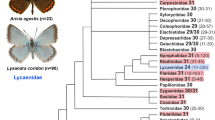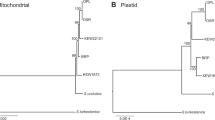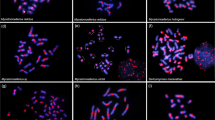Abstract
We comparatively analyzed six Dichotomius species (Coleoptera: Scarabainae) through cytogenetic methods and mitochondrial genes sequencing in the aim to identify patterns of chromosomal evolution and heterochromatin differentiation in the group. The chromosomal data were accessed through the classical analysis of heterochromatin and mapping of high and moderately repeated DNAs (C 0 t-1 DNA fraction). Mitochondrial data were obtained from nucleotide sequences of the cytochrome oxidase I (COI) and 16S rRNA genes. The heterochromatin distribution was conserved but revealed variability in the base pair richness and repetitive DNA content, and an intense turnover of heterochromatic associated sequences seems to have occurred during Dichotomius speciation. Specifically for D. bos, an interesting pattern was observed, indicating apparently the presence of heterochromatic sequences composed of low copy-number sequences. Moreover, highly conserved terminal/sub-terminal sequences that could act as a telomeric or telomere-associated DNA were observed. The heterochromatin diversification patterns observed in Dichotomius were not accomplished by the diversification of the species studied, which may be a consequence of the intense dynamics that drive the evolution of repeated DNA clusters in the genome. Finally our findings also suggest that the use of C 0 t-1 DNA fraction represents a powerful, inexpensive and not time consuming tool to be applied in understanding heterochromatin and repetitive DNA organization.




Similar content being viewed by others

References
Adega F, Chaves R, Guedes-Pinto H (2008) Suiformes orthologous satellite DNAs as a hallmark of Pecari tajacu and Tayassu pecari (Tayassuidae) evolutionary rearrangements. Micron 39:1281–1287
Altschul SF, Gish W, Miller W, Myers EW, Lipman DJ (1990) Basic local alignment search tool. J Mol Biol 215:403–410
Ansari HA, Ellison NW, Griffiths AG, Williams WM (2004) A lineage-specific centromeric satellite sequence in the genus Trifolium. Chromosome Res 12:357–367
Bione E, Moura RC, Carvalho R, Souza MJ (2005a) Karyotype, C-and fluorescence banding pattern, NOR location and FISH study of five Scarabaeidae (Coleoptera) species. Gen Mol Biol 26:376–381
Bione E, Camparoto ML, Simões ZLP (2005b) A study of the constitutive heterochromatin and nucleolus organizer regions of Isocopris inhiata and Diabroctis mimas (Coleoptera: Scarabaeidae, Scarabaeinae) using C-banding, AgNO3 staining and FISH techniques. Gen Mol Biol 28:111–116
Brutlag DL, Peacock, WJ (1975) The eukaryote chromosome. In Peacock WJ, Brock RD (eds) Canberra Australia, Australian University Press, pp 35–45
Cabral-de-Mello DC, Moura RC, Carvalho R, Souza MJ (2010a) Cytogenetic analysis of two related Deltochilum (Coleoptera, Scarabaeidae) species: diploid number reduction, extensive heterochromatin addition and differentiation. Micron 41:112–117
Cabral-de-Mello DC, Moura RC, Martins C (2010b) Chromosomal mapping of repetitive DNAs in the beetle Dichotomius geminatus provides the first evidence for an association of 5S rRNA and histone H3 genes in insects, and repetitive DNA similarity between the B chromosome and A complement. Heredity 104:393–400
Cabral-de-Mello DC, Oliveira SG, Ramos IC, Moura RC (2008) Karyotype differentiation patterns in species of the subfamily Scarabaeinae (Scarabaeidae: Coleoptera). Micron 39:1243–1250
Casacuberta E, Pardue ML (2003) Transposon telomeres are widely distributed in the Drosophila genus: TART elements in the virilis group. Proc Natl Acad Sci USA 100:3363–3368
Charlesworth B, Sniegowski P, Stephan W (1994) The evolutionary dynamics of repetitive DNA in eukaryotes. Nature 371:215–220
Colomba MS, Vitturi R, Libertini A, Gregorini A, Zunino M (2006) Heterochromatin of the scarab beetles, Bubas bison (Coleoptera: Scarabaeidae) II. Evidence for AT-rich compartmentalization and a high amount of rDNA copies. Micron 37:47–51
Colomba MS, Vitturi R, Zunino M (2000) Karyotype analyzes, banding, and fluorescent in situ hybridization in the Scarab beetle Gymnopleurus sturmi McLeady (Coleoptera, Scarabaeoidea, Scarabaeidae). J Heredity 91:260–264
Cox AV, Bennett ST, Parokonny AS, Kenton A, Callimassia MA, Bennett MD (1993) Comparison of plant telomere locations using a PCR-generated synthetic probe. Ann Botany 72:239–247
Dimitri P (1991) Cytogenetic analysis of the second chromosome heterochromatin of Drosophila melanogaster. Genetics 127:553–564
Dover GA (1986) Linkage disequilibrium and molecular drive in the rDNA gene family. Genetics 122:249–252
Edgar RC (2004) MUSCLE: Multiple sequence alignment with high accuracy and high throughput. Nucleic Acids Res 32:1792–1797
Eickbush TH, Eickbush DG (2007) Finely orchestrated movements: Evolution of the ribosomal RNA genes. Genetics 175:477–485
Ferreira IA, Martins C (2008) Physical chromosome mapping of repetitive DNA sequences in Nile tilapia Oreochromis niloticus: evidences for a differential distribution of repetitive elements in the sex chromosomes. Micron 39:411–418
Fuchs J, Brandes A, Schubet I (1995) Telomere sequence localization and karyotype evolution in higher plants. Plant Syst Evol 196:227–241
Gatti M, Pimpinelli S (1992) Functional elements in Drosophila melanogaster heterochromatin. Annu Rev Genet 26:239–275
Hall TA (1999) BioEdit: a user-friendly biological sequence alignment editor and analysis program for Windows 95/98/NT. Nucl Acids Symp Ser 41:95–98
Henikoff S, Ahmad K, Malik HS (2001) The centromere paradox: stable inheritance with rapidly evolving DNA. Science 293:1098–1102
Huelsenbeck JP, Ronquist F, Nielsen R, Bollback JP (2001) Bayesian inference of phylogeny and its impact of evolutionary biology. Science 294:2310–2314
Kimura M (1980) A simple method for estimating evolutionary rate of base substitutions through comparative studies of nucleotide sequences. J Mol Evol 16:111–120
Lohe AR, Hilliker AJ, Roberts PA (1993) Mapping simple repeated DNA sequences in heterochromatin of Drosophila melanogaster. Genetics 134:1149–1174
Martínez-Navarro EM, Serrano J, Galián J (2004) Chromosome evolution in ground beetles: localization of the rDNA loci in the tribe Harpalini (Coleoptera, Carabidae). J Zool Syst Evol Res 42:38–43
Martins C, Ferreira IA, Oliveira C, Foresti F, Galetti PM Jr (2006) A tandemly repetitive centromeric DNA sequence of the fish Hoplias malabaricus (Characiformes: Erythrinidae) is derived from 5S rDNA. Genetica 127:133–141
Meyne J, Ratliff RL, Moyzis RK (1989) Conservation of the human telomere sequence (TTAGGG)n among vertebrates. Proc Natl Acad Sci USA 86:7049–7053
Miklos GLG (1985) Localized highly repetitive DNA sequences in vertebrate and invertebrate genomes. In: Macintyre RJ (ed) Molecular evolutionary genetics. Plenum Press, New York, pp 241–321
Moura RC, Souza M, Mel NF, Lira-Neto AC (2003) Karyotypic characterization of representatives from Melolonthinae (Coleoptera, Scarabaeidae): Karyotypic analysis, banding and fluorescent in situ hybridization (FISH). Hereditas 138:200–206
Okazaki S, Tsuchida K, Maekawa H, Ishikawa H, Fujiwara H (1993) Identification of a pentanucleotide telomeric sequence, (TTAGG)n, in the silkworm Bombyx mori and in other insects. Mol Cell Biol 13:1424–1432
Palomeque T, Lorite P (2008) Satellite DNA in insects: a review. Heredity 100:564–573
Peterson DG, Schulze SR, Sciara EB, Lee SA, Bowers JE, Nagel A, Jiang N, Tibbitts DC, Wessler SR, Paterson AH (2002) Integration of Cot analysis, DNA cloning, and high-throughput sequencing facilitates genome characterization and gene discovery. Genome Res 12:795–807
Posada D, Crandall KA (1998) Modeltest: testing the model of DNA substitution. Bioinformatics 1:817–818
Ronquist F, Huelsenbeck JP (2003) MrBayes 3: Bayesian phylogenetic inference under mixed models. Bioinformatics 19:1572–1574
Rożek M, Lachowska D, Petitpierre E, Holecová M (2004) C-bands on chromosomes of 32 beetle species (Coleoptera: Elateridae, Cantharidae, Oedemeridae, Cerambycidae, Chrysomelidae and Curculionidae). Hereditas 140:1–10
Sahara K, Marec F, Traut W (1999) TTAGG telomeric repeats in chromosomes of some insects and other arthropods. Chromosome Res 7:449–460
Sambrook J, Russel DW (2001) Molecular cloning. A laboratory manual, 3rd edn. Cold Spring Harbor Laboratory Press, New York
Sánchez-Gea JF, Serrano J, Galián J (2000) Variability in rDNA loci in Iberian species of the genus Zabrus (Coleoptera: Carabidae) detected by fluorescence in situ hybridization. Genome 43:22–28
Schmidt T, Heslop-Harrison JS (1998) Genomes, genes and junk: the large-scale organization of plant chromosomes. Trends Plant Sci 3:195–199
Schneider MC, Rosa SP, Almeida MC, Costa C, Cella DM (2007) Chromosomal similarities and differences among four Neotropical Elateridae (Conoderini and Pyrophorini) and other related species, with comments on the NOR patterns in Coleoptera. J Zool Syst Evol Res 45:308–316
Schweizer D, Mendelak M, White MJD, Contreras N (1983) Cytogenetics of the parthenogenetic grasshopper Warramaba virgo and its bisexual relatives. X. Pattern of fluorescent banding. Chromosoma 88:227–236
Silva GM, Bione EG, Cabral-de-Mello DC, Moura RC, Simões ZLP, Souza MJ (2009) Comparative cytogenetics study in three species of the genus Dichotomius (Coleoptera: Scarabaeidae). Gen Mol Biol 32:276–280
Smith SG, Virkki N (1978) Coleoptera. In: John B (ed) Animal cytogenetics borntraeger, Stuttgard, Berlin, p 366
Sumner AT (1972) A simple technique for demonstrating centromeric heterochromatin. Exp Cell Res 75:304–306
Sumner AT (2003) Chromosomes: organization and function, 1st edn. Blackwell Publishing company, London
Tamura K, Dudley J, Nei M, Kumar S (2007) MEGA4: molecular evolutionary genetics analysis (MEGA) software version 4.0. Mol Biol Evol 24:1596–1599
Ugarković D, Plohl M (2002) Variation in satellite DNA profiles–causes and effects. The EMBO J 21:5955–5959
Ward RD, Zemlak TS, Innes BH, Last PR, Hebert PDN (2005) DNA barcoding Australia’s fish species. Phil Trans R Soc B 360:1847–1857
Xia X, Xie Z (2001) DAMBE: Data analysis in molecular biology and evoluiton. J Heredity 92:371–373
Yadav JS, Pillai RK (1979) Evolution of karyotypes and phylogenetic relationships in Scarabaeidae (Coleoptera). Zool Anz 202:105–118
Yamada K, Nishida-Umehara C, Matsuda Y (2002) Characterization and chromosomal distribution of novel satellite DNA sequences of the lesser rhea (Pterocnemia pennata) and the greater rhea (Rhea americana). Chromosome Res 10:513–523
Zhang YJ, Kamnert I, López CC, Cohn M, Edström JE (1994) A family of complex tandem DNA repeats in the telomeres of Chironomus pallidivittatus. Mol Cell Biol 14:8028–8036
Zwick MS, Hanson RE, McKnight TD, Nurul-Islam-Faridi M, Stelly DM (1997) A rapid procedure for the isolation of C0t–1 DNA from plants. Genome 40:138–142
Acknowledgments
This study was supported by Fundação de Amparo a Pesquisa do Estado de São Paulo (FAPESP), Coordenadoria de Aperfeiçoamento de Pessoal de Nível Superior (CAPES), Conselho Nacional de Desenvolvimento Científico e Tecnológico (CNPq) and Fundação de Amparo a Ciência e Tecnologia do Estado de Pernambuco (FACEPE). The authors are grateful to Fernando Augusto Barbosa Silva for the taxonomic identification of the specimens analyzed in this study and to PIBIC/CNPq/UPE scholarship of Melo AS.
Author information
Authors and Affiliations
Corresponding author
Rights and permissions
About this article
Cite this article
Cabral-de-Mello, D.C., de Moura, R.C., de Souza Melo, A. et al. Evolutionary dynamics of heterochromatin in the genome of Dichotomius beetles based on chromosomal analysis. Genetica 139, 315–325 (2011). https://doi.org/10.1007/s10709-011-9551-7
Received:
Accepted:
Published:
Issue Date:
DOI: https://doi.org/10.1007/s10709-011-9551-7



